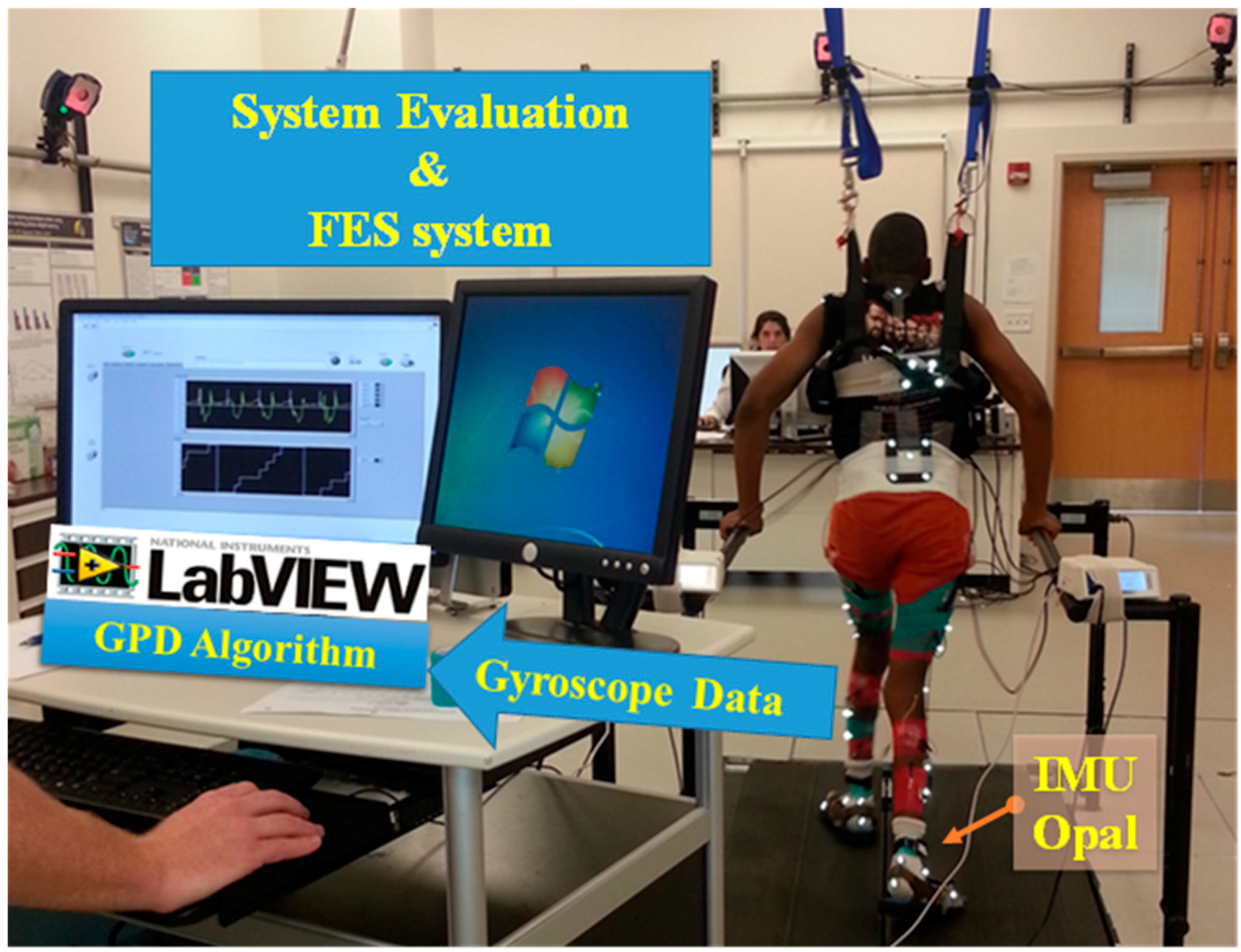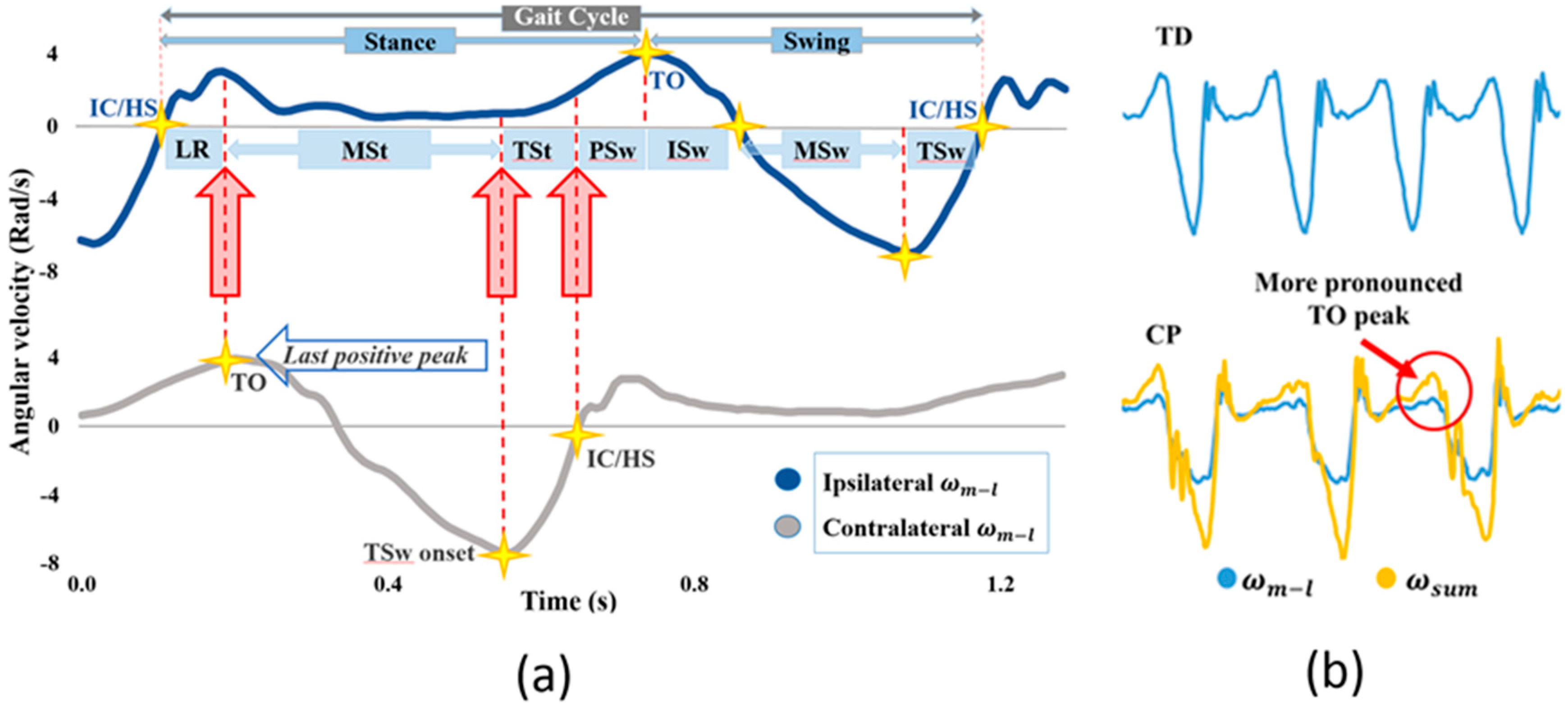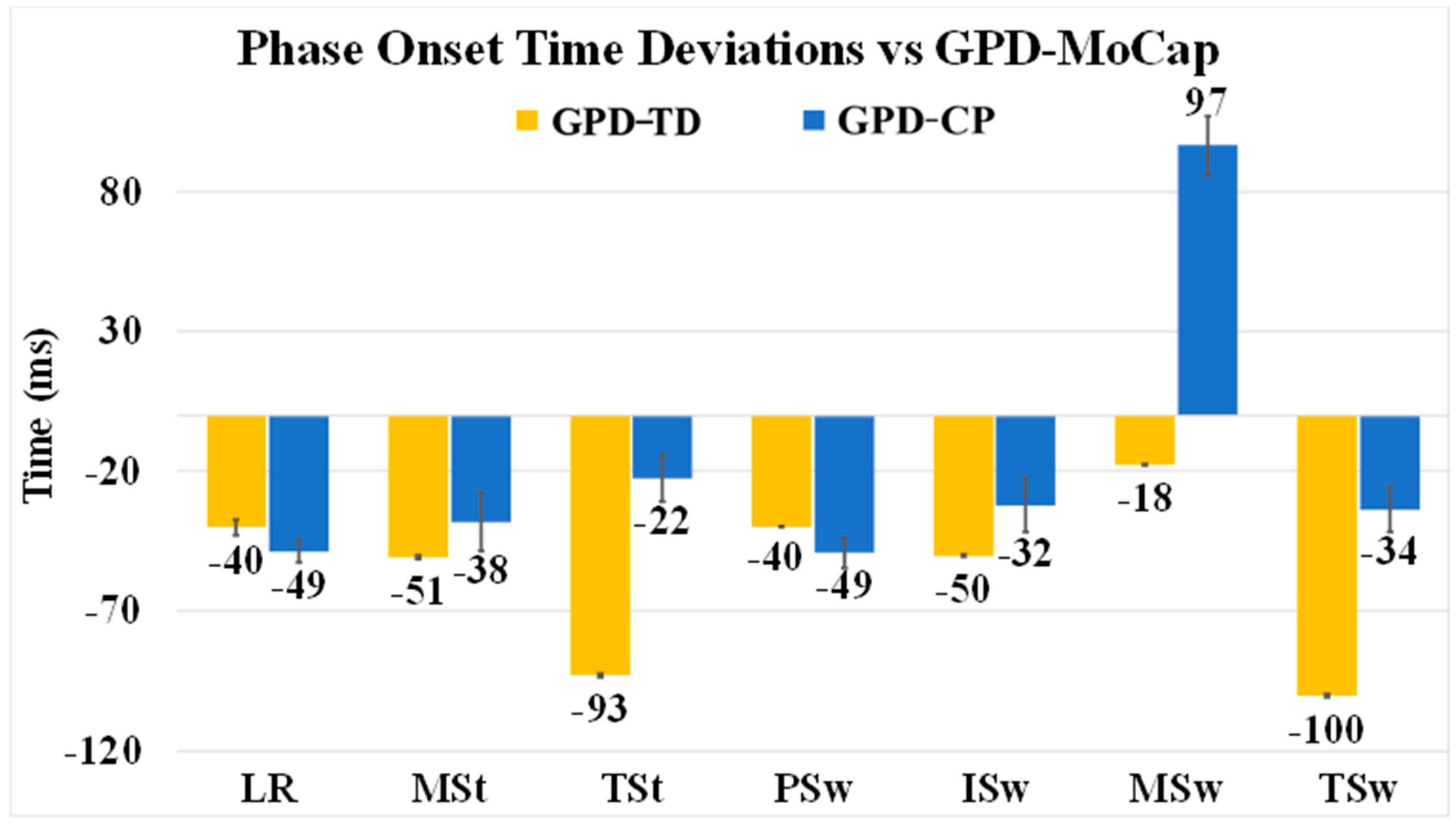Real-Time Detection of Seven Phases of Gait in Children with Cerebral Palsy Using Two Gyroscopes
Abstract
1. Introduction
2. Materials and Methods
2.1. Participants
2.2. Gait Phase Detection for Healthy Subjects
2.3. Tunable Parameters
2.4. Gait Phase Detection in Children with CP
2.5. Auto-Thresholding
2.6. Real-Time GPD Simulator
2.7. System Evaluation
2.7.1. GPD-TD to GPD-FSR
2.7.2. GPD-TD to GPD-MoCap
2.7.3. GPD-CP to MoCap
3. Results
3.1. GPD-TD vs. GPD-FSR
3.2. GPD-TD vs. GPD-MoCap
3.3. GPD-CP vs. GPD-MoCap
4. Discussion
5. Conclusions
Author Contributions
Funding
Acknowledgments
Conflicts of Interest
Appendix A
| ParticipAnt Number | GMFCS Level | Gait Phase | ||||||
|---|---|---|---|---|---|---|---|---|
| LR | MSt | TSt | PSw | ISw | MSw | TSw | ||
| 1 | 3 | 81.6 | 162 | 52 | 82 | 127 | 196 | 58 |
| 2 | 3 | 68.9 | 124 | 84 | 70.0 | 133 | 155 | 77 |
| 3 | 2 | 38 | 48 | 50 | 38.7 | 49 | 95 | 56 |
| 4 | 2 | 58 | 20 | 80 | 60 | 18 | 71 | 73 |
| 5 | 2 | 59 | 39 | 71 | 59 | 39 | 60 | 80 |
References
- Yu, L.; Zheng, J.; Wang, Y.; Song, Z.; Zhan, E. Adaptive method for real-time gait phase detection based on ground contact forces. Gait Posture 2015, 41, 269–275. [Google Scholar] [CrossRef]
- Gage, J.R. Gait analysis. An essential tool in the treatment of cerebral palsy. Clin. Orthop. Relat. Res. 1993, 288, 126–134. [Google Scholar]
- Sutherland, D.H.; Davids, J.R. Common Gait Abnormalities of the Knee in Cerebral Palsy. Clin. Orthop. Relat. Res. 1993, 288, 139–147. [Google Scholar]
- DeLuca, P.A.; Davis, R.B.; Õunpuu, S.; Rose, S.; Sirkin, R. Alterations in surgical decision making in patients with cerebral palsy based on three-dimensional gait analysis. J. Pediatr. Orthop. 1997, 17, 608–614. [Google Scholar] [CrossRef]
- Damiano, D.L.; Abel, M.F. Relation of gait analysis to gross motor function in cerebral palsy. Dev. Med. Child Neurol. 1996, 38, 389–396. [Google Scholar] [CrossRef] [PubMed]
- Perry, J. Gait Analysis: Normal and Pathological Function, 1st ed.; Slack Incorporated: Thorofare, NJ, USA, 1992; Volume 12, ISBN 9781556421921. [Google Scholar]
- Zheng, E.; Vitiello, N.; Wang, Q. Gait phase detection based on non-contact capacitive sensing: Preliminary results. In Proceedings of the IEEE International Conference on Rehabilitation Robotics, Nanyang Technological University, Singapore, 11–14 August 2015; Volume 2015, pp. 43–48. [Google Scholar]
- Senanayake, C.M.; Arosha Senanayake, S.M.N. Computational intelligent gait-phase detection system to identify pathological gait. IEEE Trans. Inf. Technol. Biomed. 2010, 14, 1173–1179. [Google Scholar] [CrossRef]
- Behboodi, A.; Wright, H.; Zahradka, N.; Lee, S.C.K. Seven phases of gait detected in real-time using shank attached gyroscopes. In Proceedings of the Annual International Conference of the IEEE Engineering in Medicine and Biology Society (EMBS), Milan, Italy, 25–29 August 2015; Volume 2015, pp. 5529–5532. [Google Scholar]
- Lauer, R.T.; Smith, B.T.; Betz, R.R. Application of a neuro-fuzzy network for gait event detection using electromyography in the child with cerebral palsy. IEEE Trans. Biomed. Eng. 2005, 52, 1532–1540. [Google Scholar] [CrossRef] [PubMed]
- Lee, J.K.; Park, E.J. Quasi real-time gait event detection using shank-attached gyroscopes. Med. Biol. Eng. Comput. 2011, 49, 707–712. [Google Scholar] [CrossRef]
- Tong, K.; Granat, M.H. A practical gait analysis system using gyroscopes. Med. Eng. Phys. 1999, 21, 87–94. [Google Scholar] [CrossRef]
- Agostini, V.; Gastaldi, L.; Rosso, V.; Knaflitz, M.; Tadano, S. A wearable magneto-inertial system for gait analysis (H-gait): Validation on normalweight and overweight/obese young healthy adults. Sensors 2017, 17, 2406. [Google Scholar] [CrossRef]
- Ryoo, M.S.; Aggarwal, J.K. Hierarchical recognition of human activities interacting with objects. In Proceedings of the IEEE Computer Society Conference on Computer Vision and Pattern Recognition, Minneapolis, MN, USA, 17–22 June 2007. [Google Scholar]
- Prochazka, A.; Schatz, M.; Tupa, O.; Yadollahi, M.; Vysata, O.; Walls, M. The MS kinect image and depth sensors use for gait features detection. In Proceedings of the 2014 IEEE International Conference on Image Processing (ICIP 2014), Paris, France, 27–30 October 2014; pp. 2271–2274. [Google Scholar]
- Boulgouris, N.V.; Huang, X. Gait recognition using hmms and dual discriminative observations for sub-dynamics analysis. IEEE Trans. Image Process. 2013, 22, 3636–3647. [Google Scholar] [CrossRef] [PubMed]
- Miller, A. Gait event detection using a multilayer neural network. Gait Posture 2009, 29, 542–545. [Google Scholar] [CrossRef] [PubMed]
- Awad, L.N.; Bae, J.; O’Donnell, K.; De Rossi, S.M.M.; Hendron, K.; Sloot, L.H.; Kudzia, P.; Allen, S.; Holt, K.G.; Ellis, T.D.; et al. A soft robotic exosuit improves walking in patients after stroke. Sci. Transl. Med. 2017, 9, eaai9084. [Google Scholar] [CrossRef]
- Skelly, M.M.; Chizeck, H.J. Real-time gait event detection for paraplegic FES walking. IEEE Trans. Neural Syst. Rehabil. Eng. 2001, 9, 59–68. [Google Scholar] [CrossRef] [PubMed]
- Pappas, I.P.I.; Popovic, M.R.; Keller, T.; Dietz, V.; Morari, M. A reliable gait phase detection system. IEEE Trans. Neural Syst. Rehabil. Eng. 2001, 9, 113–125. [Google Scholar] [CrossRef] [PubMed]
- Kotiadis, D.; Hermens, H.J.; Veltink, P.H. Inertial Gait Phase Detection for control of a drop foot stimulator. Inertial sensing for gait phase detection. Med. Eng. Phys. 2010, 32, 287–297. [Google Scholar] [CrossRef]
- Monaghan, C.C.; van Riel, W.J.B.M.; Veltink, P.H. Control of triceps surae stimulation based on shank orientation using a uniaxial gyroscope during gait. Med. Biol. Eng. Comput. 2009, 47, 1181–1188. [Google Scholar] [CrossRef]
- Rueterbories, J.; Spaich, E.G.; Andersen, O.K. Gait event detection for use in FES rehabilitation by radial and tangential foot accelerations. Med. Eng. Phys. 2014, 36, 502–508. [Google Scholar] [CrossRef] [PubMed]
- Catalfamo, P.; Ghoussayni, S.; Ewins, D. Gait event detection on level ground and incline walking using a rate gyroscope. Sensors 2010, 10, 5683–5702. [Google Scholar] [CrossRef]
- Taborri, J.; Scalona, E.; Palermo, E.; Rossi, S.; Cappa, P. Validation of inter-subject training for hidden markov models applied to gait phase detection in children with Cerebral Palsy. Sensors 2015, 15, 24514–24529. [Google Scholar] [CrossRef] [PubMed]
- Aminian, K.; Najafi, B.; Büla, C.; Leyvraz, P.F.; Robert, P. Spatio-temporal parameters of gait measured by an ambulatory system using miniature gyroscopes. J. Biomech. 2002, 35, 689–699. [Google Scholar] [CrossRef]
- Gouwanda, D.; Gopalai, A.A. A robustreal-time gaiteventdetection using wirelessgyroscope and itsapplication on normal and alteredgaits. Med. Eng. Phys. 2015, 37, 219–225. [Google Scholar] [CrossRef]
- Taborri, J.; Rossi, S.; Palermo, E.; Patanè, F.; Cappa, P. A novel HMM distributed classifier for the detection of gait phases by means of a wearable inertial sensor network. Sensors 2014, 14, 16212–16234. [Google Scholar] [CrossRef] [PubMed]
- Qi, Y.; Soh, C.B.; Gunawan, E.; Low, K.S.; Thomas, R. Assessment of foot trajectory for human gait phase detection using wireless ultrasonic sensor network. IEEE Trans. Neural Syst. Rehabil. Eng. 2016, 24, 88–97. [Google Scholar] [CrossRef]
- Jasiewicz, J.M.; Allum, J.H.J.; Middleton, J.W.; Barriskill, A.; Condie, P.; Purcell, B.; Li, R.C.T. Gait event detection using linear accelerometers or angular velocity transducers in able-bodied and spinal-cord injured individuals. Gait Posture 2006, 24, 502–509. [Google Scholar] [CrossRef]
- Nikolić, Z.M.; Popović, D.B.; Stein, R.B.; Kenwell, Z. Instrumentation for ENG and EMG Recordings in FES Systems. IEEE Trans. Biomed. Eng. 1994, 41, 703–706. [Google Scholar] [CrossRef]
- Chester, N.C.; Durfee, W.K. Surface EMG as a fatigue indicator during FES-induced isometric muscle contractions. J. Electromyogr. Kinesiol. 1997, 7, 27–37. [Google Scholar] [CrossRef]
- Behboodi, A.; Zahradka, N.; Alesi, J.; Wright, H.; Lee, S.C.K. Use of a Novel Functional Electrical Stimulation Gait Training System in 2 Adolescents with Cerebral Palsy: A Case Series Exploring Neurotherapeutic Changes. Phys. Ther. 2019. [Google Scholar] [CrossRef]
- Zahradka, N.; Behboodi, A.; Wright, H.; Bodt, B.; Lee, S.C. Evaluation of gait phase detection delay compensation strategies to control a functional electrical stimulation system during walking. Sensors 2019, 19, 2471. [Google Scholar] [CrossRef]
- Zahradka, N. When and What to Stimulate? An Evaluation of a Custom Functional Electrical Stimulation System and Its Neuroprosthetic Effect on Gait in Children with Cerebral Palsy. Ph.D. Thesis, University of Delaware, Newark, Delaware, 2017. [Google Scholar]
- Rueterbories, J.; Spaich, E.G.; Larsen, B.; Andersen, O.K. Methods for gait event detection and analysis in ambulatory systems. Med. Eng. Phys. 2010, 32, 545–552. [Google Scholar] [CrossRef]
- Bland, J.M.; Altman, D.G. Statistical methods for assessing agreement between measurement. Biochim. Clin. 1987, 11, 399–404. [Google Scholar]
- Smith, B.T.; Coiro, D.J.; Finson, R.; Betz, R.R.; McCarthy, J. Evaluation of force-sensing resistors for gait event detection to trigger electrical stimulation to improve walking in the child with cerebral palsy. IEEE Trans. Neural Syst. Rehabil. Eng. 2002, 10, 22–29. [Google Scholar] [CrossRef] [PubMed]
- Mulroy, S.; Gronley, J.; Weiss, W.; Newsam, C.; Perry, J. Use of cluster analysis for gait pattern classification of patients in the early and late recovery phases following stroke. Gait Posture 2003, 18, 114–125. [Google Scholar] [CrossRef]
- Bowden, M.G.; Balasubramanian, C.K.; Neptune, R.R.; Kautz, S.A. Anterior-posterior ground reaction forces as a measure of paretic leg contribution in hemiparetic walking. Stroke 2006, 37, 872–876. [Google Scholar] [CrossRef]
- Hanlon, M.; Anderson, R. Real-time gait event detection using wearable sensors. Gait Posture 2009, 30, 523–527. [Google Scholar] [CrossRef] [PubMed]
- Goršič, M.; Kamnik, R.; Ambrožič, L.; Vitiello, N.; Lefeber, D.; Pasquini, G.; Munih, M. Online phase detection using wearable sensors for walking with a robotic prosthesis. Sensors 2014, 14, 2776–2794. [Google Scholar] [CrossRef]
- Park, E.S.; Park, C.I.; Lee, H.J.; Cho, Y.S. The effect of electrical stimulation on the trunk control in young children with spastic diplegic cerebral palsy. J. Korean Med. Sci. 2001, 16, 347–350. [Google Scholar] [CrossRef] [PubMed]
- Lopez-Meyer, P.; Fulk, G.D.; Sazonov, E.S. Automatic detection of temporal gait parameters in poststroke individuals. IEEE Trans. Inf. Technol. Biomed. 2011, 15, 594–601. [Google Scholar] [CrossRef]
- Whittle, M.W. Whittle’s Gait Analysis, 5th ed.; Churchill Livingstone: London, UK, 2012; ISBN 9780702042652. [Google Scholar]
- Tang, J.; Zheng, J.; Wang, Y.; Yu, L.; Zhan, E.; Song, Q. Self-tuning threshold method for real-time gait phase detection based on ground contact forces using FSRs. Sensors 2018, 18, 481. [Google Scholar] [CrossRef]






| Age (yrs) | Gender | SSWS (m/s) | GMFCS | Height (m) | Weight (kg) | |
|---|---|---|---|---|---|---|
| TD01 | 16 | M | 0.8 | N/A | 1.78 | 71.92 |
| TD02 | 10 | M | 0.8 | N/A | 1.46 | 32.55 |
| TD03 | 10 | F | 1.2 | N/A | 1.46 | 31.95 |
| TD04 | 12 | F | 1.25 | N/A | 1.59 | 43.25 |
| TD05 | 12 | F | 1 | N/A | 1.47 | 36.42 |
| TD06 | 14 | F | 1.1 | N/A | 1.55 | 52.61 |
| TD07 | 13 | F | 1.1 | N/A | 1.73 | 56.29 |
| CP01 | 15 | M | 0.6 | III | 1.67 | 32.13 |
| CP02 | 16 | M | 0.8 | III | 1.70 | 60.06 |
| CP03 | 18 | M | 0.9 | II | 1.70 | 61.97 |
| CP04 | 12 | M | 0.75 | II | 1.52 | 41.50 |
| CP05 | 13 | F | 0.8 | II | 1.45 | 81.49 |
| Mean | 13.42 | 0.93 | 1.59 | 50.18 | ||
| STD | 2.36 | 0.19 | 0.12 | 15.85 |
| Gait Phase | GPD-TD Event (ωml) | GPD-MoCap Event | GPD-FSR Event |
|---|---|---|---|
| LR Onset/HS/IC | Zero-crossing (negative to positive) [22] | IC on force plate [6] | Heel FSR on |
| MSt onset/FF | Contralateral TO [6] | Contralateral TO [6] | |
| TSt onset/HO | Contralateral TSw [6] | Contralateral TSw [6] | Heel FSR off |
| PSw onset | Contralateral IC/HS [6] | Contralateral IC [6] | |
| ISw onset/TO/EC | Last positive peak [30] | EC on force plate [6] | Toe FSR off |
| MSw onset | Zero-crossing (positive to negative) | Max knee angle [6] | |
| TSw onset | Valley [36] | Max shank angular velocity [36] |
| LR | MSt | TSt | PSw | ISw | MSw | TSw | |
|---|---|---|---|---|---|---|---|
| GPD-TD | 52 | 70 | 98 | 52 | 70 | 35 | 105 |
| GPD-CP without AT | 63 | 96 | 69 | 63 | 81 | 127 | 70 |
| GPD-CP with AT | 63 | 88 | 84 | 55 | 88 | 141 | 89 |
| Subject Number | Mean ± SE | |||||||
|---|---|---|---|---|---|---|---|---|
| 01 | 02 | 03 | 04 | 05 | 06 | 07 | ||
| GPD-TD | 23 | 23 | 27 | 17 | 28 | 16 | 21 | 22 ± 1.7 |
| GPD-CP | 21 | 13 | 38 | 24 | 16 | N/A | N/A | 22 ± 4.3 |
| Study | No. of Detected Phases | Real Time | Sensor Setup on Each Side | Onset Detection Time Error Reported |
|---|---|---|---|---|
| Lauer et al. [10] | 7 | No | 1 EMG | Yes |
| Senanayake et al. [8] | 7 | Yes | 4 FSR + 6 Inertial sensors (2 IMU) | No |
| Pappas et al. [20] | 4 | Yes | 3 FSR + 1 Gyro | Yes |
| Smith et al. [38] | 5 | Yes | 3 FSR | Yes |
| Our GPD system | 7 | Yes | 1 Gyro | Yes |
| Study | Gait Events | ||
|---|---|---|---|
| HS Mean (SD) | TO Mean (SD) | ||
| Lee et al. [11] | 19 | −3 | |
| Kotiadis et al. [21] | System 1 | ~−40 (20) | ~100 (35) |
| System 2 | ~−60 (20) | ~10 (25) | |
| Catalfamo et al. [24] | −8 (9) | 50 (14) | |
| Jasiewiz et al. [30] | System 1 | −11 (23) | 19 (34) |
| System 2 | −12 (22) | 15 (26) | |
| System 3 | −14 (23) | 23 (28) | |
| Our GPD system | −12.5 (12) | −18.5 (17) | |
© 2019 by the authors. Licensee MDPI, Basel, Switzerland. This article is an open access article distributed under the terms and conditions of the Creative Commons Attribution (CC BY) license (http://creativecommons.org/licenses/by/4.0/).
Share and Cite
Behboodi, A.; Zahradka, N.; Wright, H.; Alesi, J.; Lee, S.C.K. Real-Time Detection of Seven Phases of Gait in Children with Cerebral Palsy Using Two Gyroscopes. Sensors 2019, 19, 2517. https://doi.org/10.3390/s19112517
Behboodi A, Zahradka N, Wright H, Alesi J, Lee SCK. Real-Time Detection of Seven Phases of Gait in Children with Cerebral Palsy Using Two Gyroscopes. Sensors. 2019; 19(11):2517. https://doi.org/10.3390/s19112517
Chicago/Turabian StyleBehboodi, Ahad, Nicole Zahradka, Henry Wright, James Alesi, and Samuel. C. K. Lee. 2019. "Real-Time Detection of Seven Phases of Gait in Children with Cerebral Palsy Using Two Gyroscopes" Sensors 19, no. 11: 2517. https://doi.org/10.3390/s19112517
APA StyleBehboodi, A., Zahradka, N., Wright, H., Alesi, J., & Lee, S. C. K. (2019). Real-Time Detection of Seven Phases of Gait in Children with Cerebral Palsy Using Two Gyroscopes. Sensors, 19(11), 2517. https://doi.org/10.3390/s19112517






